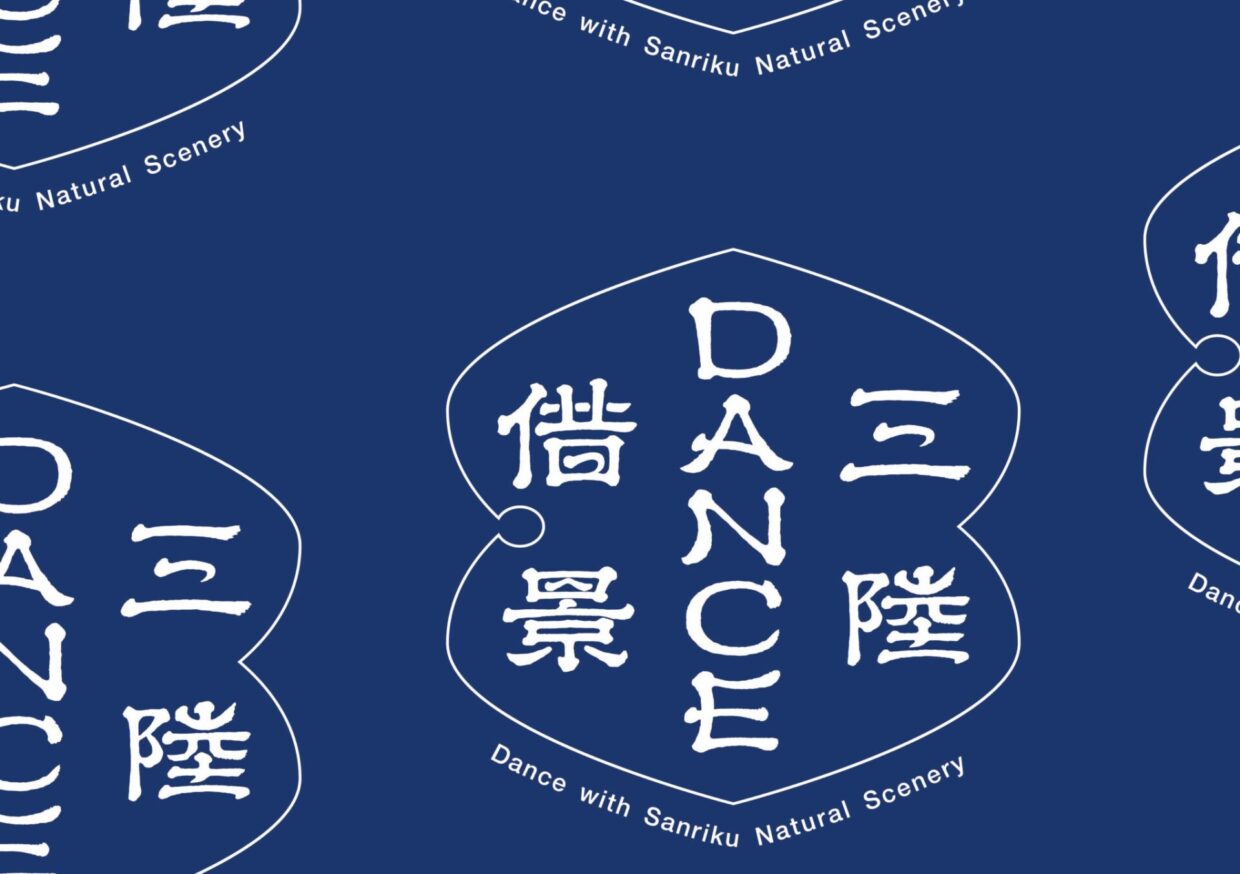三陸DANCE借景

三陸DANCE借景 Dance with Sanriku Natural Scenery
宮古市の浄土ヶ浜をはじめ沿岸や大船渡市の夏虫山など三陸沿岸の景勝地を借景に、岩手の民俗芸能とコンテンポラリーダンスの舞いを撮影します。パフォーマンスは映像作品としてオンライン配信します。
三陸に根付く芸能等の生活文化と、コンテンポラリーダンサーを通じて三陸の魅力を発信します。
This is a project to film Iwate’s local performing arts and contemporary dance using scenic spots along the Sanriku coast, including Jodogahama Beach in Miyako and Mt. Natsumushi in Ofunato, and upload the videos.With contemporary dance, we hope to bring to the world the grandeur of Sanriku’s natural beauty, which was severely damaged by the Great East Japan Earthquake and the local performing arts and lifestyle culture rooted in Sanriku.We hope you will visit the Sanriku area once the Corona disaster has settled down.
【配信】
三陸DANCE借景【6作品】
岩手県立岩泉高等学校郷土芸能同好会 中野七頭舞
Nakano Nanazumai / Local Performing Club, Iwaizumi High School
牛伏郷土芸能保存会 牛伏念仏剣舞
Ushifushi Nenbutsu-kenbai / Ushifushi Kyodogeino Hozonkai, Miyako
花輪鹿子踊り保存会 花輪鹿子踊り
Hanawa Shishiodori / Hanawa Shishiodori Hozonkai, Miyako
東野祥子 /HEAVEN/
/HEAVEN/ ANTIBODIES Collective
金津流浦浜獅子躍保存会 金津流浦浜獅子躍
Kanatsuryu Urahama Shishiodori / Kanatsuryu Urahama Shishiodori Hozonkai, Ofunato
鈴木ユキオ ひかりにふれる、海をみる
HIKARI NI FURERU,UMI WO MIRU / YUKIO SUZUKI projects
【出 演】
郷土芸能:花輪鹿子踊り(花輪鹿子踊り保存会)/牛伏念仏剣舞(牛伏郷土芸能保存会)、金津流浦浜獅子躍(金津流浦浜獅子躍保存会)/中野七頭舞(岩手県立岩泉高等学校郷土芸能同好会)
コンテンポラリーダンス:鈴木ユキオ/東野祥子(ANTIBODIES Collective)
【Profile】
■岩手県立岩泉高等学校郷土芸能同好会
郷土芸能同好会は、中野七頭舞の伝承を志す有志の集まりとして、平成2年に発足し、以来全国 大会6回、国立劇場2回、パリ公演と数々の実績を重ね現在に至る。中野七頭舞は「天保の七年 飢渇」が起きた頃に黒森神楽の「シットギジシ舞」を基本として創作されたと伝えられており、踊り 手はの七つの役割に分かれ、舞も七種類あることから七頭舞の由来となる。七頭舞では、原野を 開墾し、作物を植え、害獣から守り、収穫を分かち合う農民の日々の営みを演じる。
Iwaizumi High School, Local Performing Arts Club The Local Performing Arts Club was established in 1990 as a group of volunteers who wanted to hand down the tradition of Nakano Nanazumai. Since then, the members have participated in national competitions six times, performed at the National Theatre twice, and performed in Paris. The Nakano Nanazumai is said to be originated in the Tempo era (1831-1845) and to be developed from a specific part of kagura dance called “Shittogijishi”. The dancers are divided into seven roles and there are seven types of dances, hence the name Nanazumai (nana means seven). In the Nanazumai performance, the daily activities of farmers who cultivate the wilderness, plant crops, protect them from vermin, and share the harvest are performed.
■牛伏念仏剣舞
建久元年(1190年)鎮西八郎為朝の三男為頼は、鎌倉幕府将軍源頼朝より閉伊・気仙の所領を安 堵され、老木村根城に館を築いて閉伊頼基と名のった。頼基は父の菩提を弔うために華厳院を建 立し、祖先や源氏一族・敵方平家などの戦没将士の霊を慰めるために、将士27人に踊らせ供養 したのが牛伏剣舞の始まりと言われている。毎年お盆には地区の各家をまわって死者や祖先の 霊をなぐさめ、16日には花原市の華厳院で剣舞と七ツ踊りを供養として奉納している。
Ushifushi Nenbutsu Kenbai In 1190, Chinzei Hachiro Tametomo’s third son, Minamoto no Tameyori, was granted his territory in Hei and Kesen by Minamoto no Yoritomo, the first shogun of the Kamakura shogunate. He built a castle in Nejo, Roki, and took on the name of Hei Yorimoto. Yorimoto built Kegon-in temple in dedication to the soul of his father, where he had 27 soldiers dance for the souls of ancestors and of the Minamoto clan and also of its rival Taira clan killed in the war. This is believed to be the origin of the Ushifushi Kembai. During the annual Bon Festival in August, the dancers go around houses in the area to appease the souls of ancestors and the recently departed. On the 16th, it ritually performs its kenbai and nanatsu-odori (seven-item dance) at the Kegon-in temple in Kebaraichi to pray for the dead.
■花輪鹿子踊
根城館に居を構えた閉伊頼基の家臣、花輪次郎なる者が芸を好んで旅をし、越後から習い覚え たのが始まりと言われる。寛永8年(1631年)には、花輪殿様で知られる南部二十九代重信公 が、花輪より盛岡に召される時の御供につき、盛岡城の御前で披露して南部家の九曜紋と向鶴 の紋の使用を許されたといわれている。毎年、4月の華森神社例大祭で奉納し、盆の15日には 花輪伝承館で鹿子踊りを披露して祖先を供養している。
Hanawa Shishiodori Hei Yorimoto, who had made his home at Nejo Castle, had a vassal called Hanawa Jiro who was a performing arts enthusiast. This Hanawa is said to have learned this dance while traveling around in Echigo. In 1631, he accompanied Nanbu Shigenobu – the twenty-ninth head of the Nanbu clan, affectionately known as “Hanawa Tonosama” (Lord Hanawa) – when the latter was summoned to Morioka from Hanawa. He performed the dance at Morioka Castle, and was granted the use of the Nanbu clan’s kuyo (nine-star) and mukaizuru (facing cranes) crests. Every year, the dance is dedicated to the gods at Hanamori Shrine’s annual festival in April, and is performed on August 15 during the Bon Festival at the Hanawa Tradition Museum, to pray for the souls of ancestors.
■金津流浦浜獅子躍保存会
大船渡市三陸町越喜来浦浜地区には、享保8年(1723)仙台藩主伊達吉村公が藩境巡国の際 に、勢子3千人を率いて越喜来浦浜で鹿狩りをしたことが由来とされる鹿踊があったが途絶えてい た。平成2年、浦浜の11人が金津流梁川獅子躍(奥州市江刺区)に入門し、稽古を経て翌年「頭渡 しの儀」を挙行。大正後半に姿を消した浦浜鹿踊が約80年ぶりに「金津流浦浜獅子躍」として新 生復活した。
Kanatsu-ryu Urahama Shishiodori In 2000, 11 people from Urahama went to study the Kanatsuryu Yanagawa Shishiodori (Esashi Ward, Oshu) with the goal of reviving the Urahama Shishiodori, which had died out in the late Taisho period. After undergoing training, they performed the touwatashi-no-gi (ritual handover of shrine-caretaking duties) the following year after seventy-odd years of inactivity, hoping to restore the dance under the name of Kanatsuryu Urahama Shishiodori. A key characteristic of the Kanatsuryu style is that its performers sing, dance and play the accompaniment all by themselves. A dance that combines a rustic simplicity with dignity and grace, it has been introduced widely at home and abroad as a local folk shishiodori dance.
■東野祥子(ANTIBODIES COLLECTIVE)
2015年、舞踊家・東野祥子と音楽家・カジワラトシオを基軸とし、京都を拠点に発足した『抗体』の 意味を持つパフォーマンスアーティストコレクティブ。大規模な美術、音楽、映像、装置などと強度 あるパフォーマーが有機的に関わりあうコラボレーションの可能性を追求し、社会性の強い総合 舞台芸術、インスタレーション作品などの発表、地域社会へ参加するワークショップ等の活動を国 内外にて展開する。舞台と日常を往来するような感覚を呼ぶ独自の鑑賞スタイル【自由回遊型】を 提唱し、ジャンルの境界を打破した不思議な作品スタイルで、幅広い観客層を魅了する。
A performance artist collective with the meaning of “antibody” founded in 2015 based in Kyoto, Japan, with dancer Shoko Higashino and musician Toshio Kajiwara as its core members. They pursue the possibility of collaboration in which strong performers organically interact with large-scale art, music, video, and equipment, and develop activities both in Japan and abroad, including presentations of socially conscious performing arts and installations, and workshops that involve participation in local communities. They advocate a unique viewing style (free circulation type) that calls for a sensation of coming and going between the stage and everyday life, and attract a wide range of audiences with a mysterious style of work that breaks down the boundaries of genres.
■鈴木ユキオ
YUKIO SUZUKI projects 代表・振付家・ダンサー。世界40都市を超える地域で活動を展開し、し なやかで繊細に、空間からはみだすような強靭な身体・ダンスは、多くの観客を魅了している。モ デル、音楽家との共同制作、子供や障害のある方へのワークショップなど、活動は多岐に渡る。 2008年トヨタコレオグラフィーアワード「次代を担う振付家賞」等受賞多数。
www.suzu3.com Director of YUKIO SUZUKI projects, Choreographer, Dancer He has been active in more than 40 cities around the world, and his flexible, delicate, and strong body and dance, which seems to protrude from the space, attracts many audiences. He has received numerous awards, including the Toyota Choreography Award 2008 for “Choreographer of the Next Generation”.
文化庁令和2年度戦略的芸術文化創造推進事業「JAPAN LIVE YELL project」
アーツライブいわて
三陸DANCE借景
主催:文化庁、公益社団法人日本芸能実演家団体協議会、アーツライブいわて実行委員会、NPO法人いわてアートサポートセンター
共催:宮古市、宮古市教育委員会
協力:(一社)宮古観光文化交流協会、三陸国際芸術推進委員会事務局、みんなのしるし合同会社、(一社)三陸コクリ、(一社)ダンス・ニッポン・アソシエイツ、(一社)ANTIBODIES Collective、岩手県立岩泉高等学校、NPO法人みちのくトレイルクラブ、NPO法人震災リゲイン
【問合せ】
NPO法人いわてアートサポートセンター TEL.019‐656‐8145(月~金 9:00~18:00)
【試写会+トーク・ショーイング】
宮古市の浄土ヶ浜や大船渡市の夏虫山など三陸沿岸の景勝地を借景に、岩手の民俗芸能とコンテンポラリーダンスの舞いを撮影し、映像作品とする『三陸ダンス借景』。映像の完成を記念して1回限りの試写会を開催!当日は鈴木ユキオ・東野祥子によるオープニングダンスセッションやアフタートークも!
日時:2021.2.21(日) 14:00上映開始(13:40開場)
場所:もりおか町家物語館 浜藤ホール
定員:40名(完全予約制) 入場無料
申込方法:お申し込みはこちら

